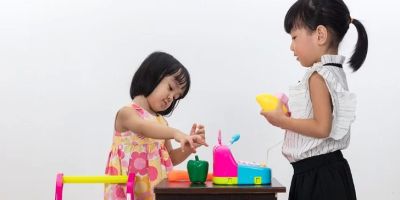Best Toy Kitchens for Imaginative Play
- Why Toy Kitchens Are Important for Creative Play
- Top-Rated Toy Kitchens for Kids
- How to Choose the Right Toy Kitchen for Your Child
- Benefits of Pretend Play with Toy Kitchens
- Tips for Maximizing Playtime with Toy Kitchens
1. Why Toy Kitchens Are Important for Creative Play
Toy kitchens are among the best tools to spark creativity and imaginative play in children. Pretend play, especially in a kitchen setting, allows kids to step into the role of an adult, offering them a chance to explore everyday life in a safe and playful way. Toy kitchens stimulate a child’s imagination and allow them to mimic the actions they observe around them—whether it's cooking meals, setting the table, or cleaning up after dinner.
As children engage in role-play, they not only develop storytelling skills but also learn about real-world scenarios, like family routines, nutrition, and the importance of cooperation. They create fun stories around meal preparation, share responsibilities, and work together in their pretend kitchen. This type of imaginative play helps children develop a deeper understanding of daily activities while honing their fine motor skills and problem-solving abilities.
2. Top-Rated Toy Kitchens for Kids
When selecting the best toy kitchens for imaginative play, it’s important to choose products that are durable, safe, and encourage open-ended play. Here are some top-rated toy kitchens that provide a fantastic experience for kids:
- KidKraft Wooden Kitchen Set: KidKraft is a leading brand known for its high-quality wooden toys. Their toy kitchen sets come in various sizes and themes, including classic kitchen designs and modern setups. These kitchens often feature realistic elements like ovens, sinks, and refrigerators, making them a great choice for children who enjoy mimicking adult activities.
- Melissa & Doug Chef's Kitchen: A well-loved option among parents, Melissa & Doug’s wooden kitchen sets are sturdy and offer plenty of interactive elements. With a wide variety of accessories like pots, pans, and utensils, this toy kitchen set helps children expand their creativity and pretend-cooking skills.
- Step2 Lifestyle Dream Kitchen: Step2’s toy kitchens are known for their durability and ease of use. This brand offers kitchens with lots of storage space and realistic details, like electronic sounds for the stove and microwave. Step2 kitchens provide hours of interactive play while helping children develop important cognitive and social skills.
- Little Tikes Super Chef Kitchen: Little Tikes is another trusted brand that offers toy kitchens with colorful designs and plenty of interactive features. Their Super Chef Kitchen provides kids with a wide range of pretend-play opportunities, from preparing meals to hosting pretend dinner parties.
- Hape Gourmet Kitchen: For eco-conscious families, Hape offers a sustainable and high-quality wooden toy kitchen. The Hape Gourmet Kitchen is designed with vibrant colors and modern details that will keep children engaged in cooking and serving pretend meals for hours on end.
3. How to Choose the Right Toy Kitchen for Your Child
Choosing the perfect toy kitchen for your child depends on several factors, including your child’s age, interests, and available space. Here are some important considerations:
- Age Appropriateness: Make sure the toy kitchen is suitable for your child’s developmental stage. Younger children may benefit from simpler, smaller kitchens with basic features, while older kids may enjoy more intricate setups with additional accessories and interactive elements.
- Size and Space: Measure the available space in your home before purchasing a toy kitchen. If you have limited room, consider a compact kitchen or a play kitchen set that can be stored easily. Larger kitchens with multiple features are great for spacious areas.
- Material and Durability: Wooden kitchens are often more durable and eco-friendly, but plastic kitchens can be more lightweight and affordable. Consider the material that will best suit your home environment and your child’s play habits.
- Realism: Look for kitchens with realistic details like stoves with knobs that turn, sinks with running water (in some cases), and utensils and appliances that encourage authentic role-playing. Realistic kitchens help deepen the child’s engagement and make playtime more immersive.
4. Benefits of Pretend Play with Toy Kitchens
Pretend play with toy kitchens offers a multitude of benefits that can aid in a child’s development:
- Cognitive Development: As children engage with their toy kitchens, they use problem-solving skills and critical thinking to figure out how to cook, clean, or organize their kitchen. This type of play strengthens their memory and decision-making abilities.
- Social Skills: Toy kitchens encourage group play, where children work together to prepare meals, serve food, and interact with others. This promotes teamwork, sharing, and negotiation skills, all of which are key components of healthy social development.
- Creativity and Imagination: Pretend play opens up countless creative possibilities. Kids can create elaborate meals, design their own recipes, and even role-play different characters like chefs, waiters, and customers. This helps develop their storytelling abilities and boosts their imagination.
- Fine Motor Skills: Using utensils, stirring pots, and arranging plates helps children develop fine motor skills and hand-eye coordination. These skills are important for later tasks like writing, drawing, and dressing themselves.
5. Tips for Maximizing Playtime with Toy Kitchens
To make the most of your child’s toy kitchen and ensure that playtime is both enjoyable and educational, try these helpful tips:
- Engage in Play Together: While it’s great for children to play independently, joining in on the fun can enhance their experience. Help them cook a “meal” or pretend to be a customer at their restaurant. This shared playtime strengthens your bond and provides an opportunity for learning together.
- Incorporate Real-Life Learning: Use the toy kitchen to introduce basic life skills. Teach your child about different food groups, kitchen safety, and how to set the table. This helps them relate their pretend play to real-life situations.
- Rotate Accessories: Keep the play fresh by periodically introducing new utensils, pretend food items, or play recipes. This adds variety and helps maintain the child’s interest in their kitchen setup.
- Use Play to Reinforce Values: Toy kitchens provide a great way to teach important values such as sharing, patience, and responsibility. Encourage your child to take turns, clean up after play, and share their pretend food with others.
If you’re looking for the best toy kitchens for your child’s imaginative play, visit Knight Toys for a great selection. Our carefully curated collection includes high-quality kitchens that inspire creativity and provide hours of fun!





